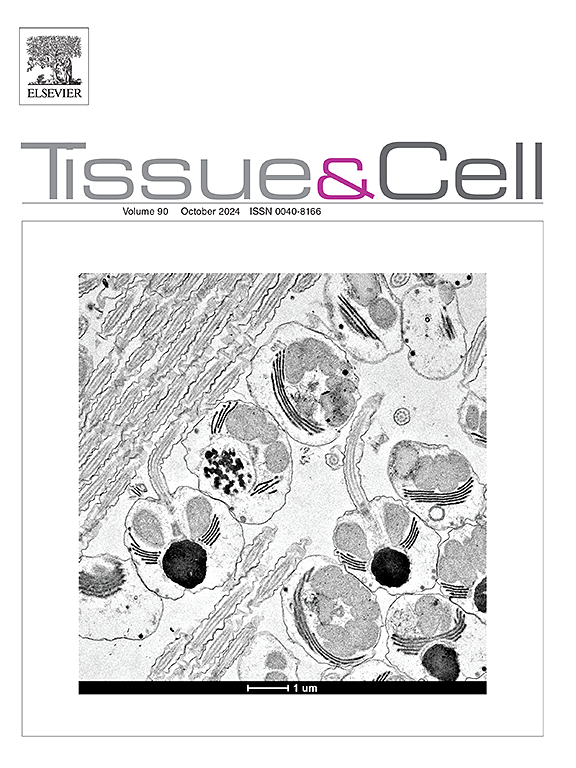Neuroprotective effects of granulocyte colony-stimulating factor against tramadol-induced cerebellar neurotoxicity
IF 2.7
4区 生物学
Q1 ANATOMY & MORPHOLOGY
引用次数: 0
Abstract
Background
Tramadol (TRM) is a centrally acting synthetic opioid and serotonin/norepinephrine reuptake inhibitor. Despite being a potent painkiller, long-term use can induce permanent neurotoxicity. Granulocyte colony-stimulating factor (G-CSF) is a cytokine that helps to mobilize stem cells and facilitate their integration over injured neurons.
Aim
This work aims to study the histopathological, biochemical, and molecular alterations in the cerebellar cortex induced by TRM in comparison to the postulated protective effect of G-CSF versus TRM withdrawal.
Methods
32 adult male albino rats were equally divided into four groups: control, TRM, TRM+G-CSF-treated, and TRM withdrawal groups. The TRM group received a daily dose of 80 mg/kg body weight orally via gastric tube for 12 weeks. The TRM+G-CSF-treated group received subcutaneous injections of 100 μg/kg body weight of G-CSF for seven consecutive days, then TRM from the 8th day. The TRM withdrawal group received TRM for 12 weeks; then, the rats were left without TRM administration for a further 12 weeks. The structural, biochemical, and molecular changes of the cerebellum were measured.
Results
The study revealed that TRM not only induced cerebellar atrophy but also triggered microgliosis, neuroinflammation, and apoptotic indicators, all while suppressing autophagy. However, G-CSF and TRM withdrawal reversed these alterations with superiority to G-CSF.
Conclusion
The current investigation shows that G-CSF may improve behavioral, neurochemical, immunohistochemical, and molecular metrics in the rat cerebellum after tramadol-induced injury. G-CSF exhibits a superior protective effect compared to tramadol withdrawal. This is achieved through its antioxidant, anti-apoptotic, and autophagic enhancement properties, as well as its ability to reduce cerebellar gliosis.
背景曲马多(TRM)是一种中枢作用的合成阿片类药物和血清素/去甲肾上腺素再摄取抑制剂。尽管曲马多是一种强效止痛药,但长期使用会引起永久性神经中毒。粒细胞集落刺激因子(G-CSF)是一种细胞因子,有助于动员干细胞并促进其整合到损伤的神经元上。方法将32只成年雄性白化大鼠平均分为四组:对照组、TRM组、TRM+G-CSF处理组和TRM停药组。TRM 组每天经胃管口服 80 毫克/千克体重的剂量,持续 12 周。TRM+G-CSF治疗组连续7天皮下注射100微克/千克体重的G-CSF,然后从第8天开始接受TRM治疗。TRM 停药组接受 TRM 治疗 12 周;然后,大鼠不再接受 TRM 治疗 12 周。研究结果表明,TRM 不仅会诱导小脑萎缩,还会引发小胶质细胞增生、神经炎症和细胞凋亡指标,同时抑制自噬。结论 目前的研究表明,G-CSF 可改善曲马多诱导损伤后大鼠小脑的行为、神经化学、免疫组化和分子指标。与曲马多停药相比,G-CSF 表现出更优越的保护作用。这是通过其抗氧化、抗凋亡和自噬增强特性及其减少小脑胶质细胞病变的能力来实现的。
本文章由计算机程序翻译,如有差异,请以英文原文为准。
求助全文
约1分钟内获得全文
求助全文
来源期刊

Tissue & cell
医学-解剖学与形态学
CiteScore
3.90
自引率
0.00%
发文量
234
期刊介绍:
Tissue and Cell is devoted to original research on the organization of cells, subcellular and extracellular components at all levels, including the grouping and interrelations of cells in tissues and organs. The journal encourages submission of ultrastructural studies that provide novel insights into structure, function and physiology of cells and tissues, in health and disease. Bioengineering and stem cells studies focused on the description of morphological and/or histological data are also welcomed.
Studies investigating the effect of compounds and/or substances on structure of cells and tissues are generally outside the scope of this journal. For consideration, studies should contain a clear rationale on the use of (a) given substance(s), have a compelling morphological and structural focus and present novel incremental findings from previous literature.
 求助内容:
求助内容: 应助结果提醒方式:
应助结果提醒方式:


